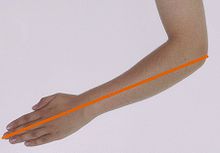Ell
| Ell | |
|---|---|

The ell was originally a cubit, later replaced by the cloth-ell or "double ell".
|
|
| Unit of | Length |
| 1 in ... | ... is equal to ... |
| Inches | 18 |
An ell (from Proto-Germanic *alinō, cognate with Latin ulna) is a unit of measurement, originally a cubit, i.e., approximating the length of a man's arm from the elbow ("elbow" means the bend or bow of the ell or arm) to the tip of the middle finger, or about 18 inches (457 mm); in later usage, any of several longer units. In English-speaking countries, these included (until the 19th century) the Flemish ell ( 3⁄4 of a yard), English ell ( 1 1⁄4 yards) and French ell ( 1 1⁄2 yards), some of which are thought to derive from a "double ell".
Several national forms existed, with different lengths, including the Scottish ell (≈37 inches or 94 centimetres), the Flemish ell [el] (≈27 in or 68.6 cm), the French ell [aune] (≈54 in or 137.2 cm) the Polish ell (≈31 in or 78.7 cm), the Danish alen (24 Danish inches or 2 Danish fod: 62.7708 cm), the Swedish aln (2 Swedish fot ≈59 cm) and the German ell [Elle] (Hamburg, Frankfurt, Cologne, Leipzig: 57.9 cm)
Select customs were observed by English importers of Dutch textiles: although all cloths were bought by the Flemish ell, linen was sold by the English ell, but tapestry was sold by the Flemish ell.
In England, the ell was usually 45 in (1.143 m), or a yard and a quarter. It was mainly used in the tailoring business but is now obsolete. Although the exact length was never defined in English law, standards were kept; the brass ell examined at the Exchequer by Graham in the 1740s had been in use "since the time of Queen Elizabeth".
...
Wikipedia
